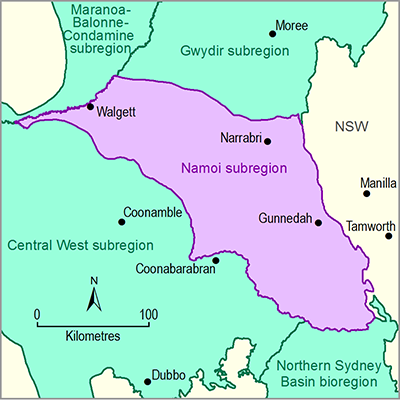2.6.2.7.2.1 Drawdown due to additional coal resource development
As discussed in Section 2.6.2.1, the primary objective of the groundwater modelling is to provide probabilistic estimates of drawdown at the regional watertable due to additional coal resource development. The regional watertable is where the majority of the ecological, economic and sociocultural assets are dependent upon water. Drawdown in the confined part of the Pilliga Sandstone is also predicted as there are economic assets dependent upon this water source.
At each model node (shown in Figure 3, Section 2.6.2.1), time series of groundwater level in the regional watertable aquifer are simulated for the baseline and the CRDP. The maximum difference in drawdown (dmax) between the modelled CRDP and baseline, due to additional coal resource development, and the year of maximum change (tmax), are calculated using the difference between the two time series. This is illustrated in Figure 21 for one model node.
Figure 21 Example of groundwater model output time series for one model node
Groundwater level is relative to height above the Australian Height Datum (AHD).
CRDP = coal resource development pathway. Additional drawdown is the maximum difference in drawdown (dmax) between the coal resource development pathway (CRDP) and baseline, due to additional coal resource development.
2.6.2.7.2.2 Change in surface water – groundwater flux due to additional coal resource development
The difference in the surface water – groundwater flux due to additional coal resource development is simulated for points along the groundwater model stream network shown in Figure 14 in Section 2.6.2.4. The changes in surface water – groundwater flux upstream of each surface water model node in Figure 14 in Section 2.6.2.4 are aggregated at the node. The resulting change in flux time series are inputs to the surface water modelling, as documented in Section 2.6.2.1 and in greater detail in companion product 2.6.1 for the Namoi subregion (Aryal et al., 2018b).
Generally, the extraction of water by coal mines causes baseflow to decrease. However, the modelling indicates that longwall mining can also increase baseflow. This is due to hydraulic conductivity enhancement above underground mines and is explained in more detail in a numerical experiment reported in the groundwater modelling product for the Hunter subregion (Herron et al., 2018). The results concluded that there are three ways that baseflow can increase due to mining:
- in the short term (weeks), water stored in the interburden can be released as the groundwater finds a new equilibrium after the enhancement of hydraulic conductivity due to the collapse of the goaf (this is modelled in the Namoi subregion groundwater model)
- when the groundwater’s new phreatic surface is deeper than prior to mining, resulting in less evapotranspiration from groundwater (this is modelled in the Namoi subregion groundwater model)
- in the longer term (years), when a new equilibrium is established, the enhanced conductivity means that: (i) groundwater moves faster due to an increase in transmissivity that more than compensates for a reduction in hydraulic gradient (this is modelled); and (ii) rainfall recharge is potentially higher (this is not modelled).
The maximum and minimum change in the surface water – groundwater flux for each time series and for each stream reach in the river model have been summarised in Figure 22. This shows that decreases in the surface water - groundwater flux occur in the vicinity of all coal resource developments but increases in surface water – groundwater flux only occur in the vicinity of longwall mines.

Product Finalisation date
- 2.6.2.1 Methods
- 2.6.2.2 Review of existing models
- 2.6.2.3 Model development
- 2.6.2.4 Boundary and initial conditions
- 2.6.2.5 Implementation of the coal resource development pathway
- 2.6.2.6 Parameterisation
- 2.6.2.7 Observations and predictions
- 2.6.2.8 Uncertainty analysis
- 2.6.2.9 Limitations
- Citation
- Currency of scientific results
- Acknowledgements
- Contributors to the Technical Programme
- About this technical product


